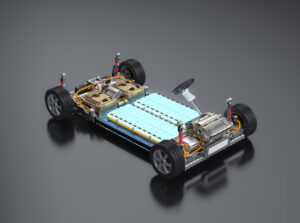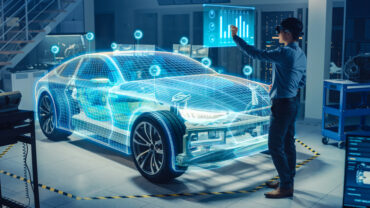
Digital twin and other technologies are essential for the design and engineering of an electric drive. Combined, they allow different types of engineers to collaborate within a single environment.
Electric vehicle manufacturers face different and new design, development, and production challenges when bringing cars to market. One area that is particularly difficult is a vehicle’s electric drive. Compared to its counterpart in an internal combustion engine vehicle, predicting motor electromagnetics, noise, heat transfer, stresses, or simulating specific phenomena on an electric drive requires new fields of expertise and mindsets.
Recently, RTInsights sat down with Steven Dom, director of automotive industry solutions within the simulation and test segment of Siemens Digital Industries Software, to talk about the issues. He noted that the design and engineering of an electric drive must be approached as a complete ecosystem where electromagnetic, thermal, mechanical, and acoustics engineers collaborate within a single environment where all aspects of engineering design, analysis, and testing are worked on at the same time and together. Dom then focused on the tools and technologies that can help make this happen.
Here is a summary of our conversation.
RTInsights: What makes an electric drive so complex and challenging to design as an engineer?
Dom: An electric drive presents a complicated multi-attribute and multi-domain problem. It is essentially a single box containing an electric motor, transmission, power electronics, and an inverter. This means you need experts in electromagnetics, electronics, gearbox design, thermal management, noise, and vibration to work together in a confined space.
Compare this to a powertrain in a combustion engine vehicle. Of course, it isn’t simple, but it performs just one function, and engineers have decades of experience building them. The transmission is built separately or purchased from a supplier, and the two are bolted together. This is how it’s worked for a long time, and manufacturers are set up for this. Developing an electric drive is a very different process and requires a different way of working.
RTInsights: Why do traditional approaches to powertrain design and engineering break down when applied to electric drives?
Dom: Traditionally, design is much more linear. One team works on the combustion element, while another works on the mechanical element.
With an electric drive, many different things must happen simultaneously. For instance, the power electronics and electric motor need to be cooled simultaneously, whereas with a combustion engine, you only worry about cooling once the combustion element is complete.
Cooling is critical for electric vehicles. Depending on where you are in the world and the current climate conditions, you need to cool or heat the battery and the cabin. In a traditional vehicle, you have an air conditioning compressor for the cabin, which is a separate system. But in an electric vehicle, there is a much bigger balancing act because every bit of power in your battery needs to be used in the optimal way possible.
RTInsights: What’s needed to bring electric drive, design, and engineering into the modern age?
Dom: You need to move away from thinking about separate subsystems and adopt a collaborative mindset, supported by a toolset and working environment.
In the past, we focused on our task and then handed it on to the next engineer when it was finished. Now, we always need to have the complete system in mind when working on individual elements. You need an open environment that supports this, which is why, even with our huge portfolio, we support integration with other vendors who provide different technologies.
This requires well-defined and well-orchestrated workflows to manage the complexity and keep everyone on the same page. Most importantly, the process is streamlined so that engineers don’t have to spend lots of time searching for models and data, making collaboration much more effective.
RTInsights: What specific technologies, such as digital twins, are being used?
Dom: It’s not so much about technology as about terminology, such as model-based system engineering. This approach has been used for a long time in the space industry. Now, over the last ten years, the automotive industry, particularly in Asia, has begun to explore it and apply it to different areas.
Once you adopt model-based system engineering you need the tools and technologies to support it. You need to have all your requirements well defined in order to think at a system level rather than at a subsystem level. You still require detailed engineering on certain parts, but this must be reintegrated.
This is where tools such as Reduced Order Modeling are important. This means taking a very detailed model and condensing it down to something that is manageable by other people. Typically, this would be a 1D simulation that runs in real time so when other people need the results, they don’t have to rerun a calculation that takes several hours. They can integrate the reduced order model and get results much quicker.
Artificial intelligence is also becoming an important technology that supports this, using neural networks to create fast running simulation models in a consistent way that helps engineering processes. Additionally, new large language model applications and data analytics applications prove to be useful in processing large amounts of data from testing to feed back into the design process.
RTInsights: How does Siemens help in all of these areas?
Dom: Siemens has a complete integrated portfolio called Xcelerator. It’s an open ecosystem designed to support customers and the different tools they use.
It starts at the product lifecycle management level with tools like Teamcenter. Underneath Teamcenter, we have more process and simulation orchestration tools in the CAE world.
What makes us unique is that we also have a broad range of test solutions within our portfolio. We don’t believe that simulation will replace testing completely. Yes, we want to reduce the amount of troubleshooting at the end of development, but you still need testing to validate your simulations. For instance, if you develop a new technology such as a nuclear-powered electric powertrain, how are you going to validate that through simulation if you have never simulated a nuclear power plant? I’m not saying that this is likely to happen, but people come up with new technologies all the time. Simulation technology can’t exist for brand new technology, so you need testing to validate it.
We also have a large group of highly skilled people who bring technology to customers. This is our engineering services team, which not only deploys tools for customers but also collaboratively develops them. With this approach, customers get the tools they need and become proficient in using them. It’s no use for us to develop tools on our own if customers don’t want them or can’t work with them, so this collaboration is really important.
RTInsights: Any final thoughts?
Dom: It’s not only different teams and engineers at one manufacturer that need to work together. It also requires close collaboration with external suppliers.
For example, a group at a large OEM was working on cooling an electric motor. They were getting their data from multiple databases, which made it difficult to know where to find the exact data they needed. When in doubt, they spoke to someone who could tell them where the information was. Fundamentally, there’s nothing wrong with that, but you need to know when to have that conversation.
Similarly, for the last few decades, lots of people have been saying they want to front-load simulation into design engineering to improve development. Yes, of course, you do, but people are still saying the same thing after almost 30 years.
What’s essential is an environment in which everyone can effectively collaborate. Call it model-based system engineering, model-based design, model-based development, or whatever you want. But you need the flexibility to ensure innovation. At the same time, you need to be able to exchange data and information and carry out engineering work much more effectively than before.







